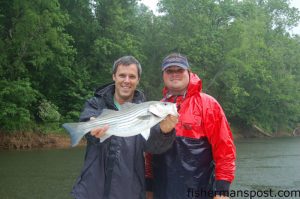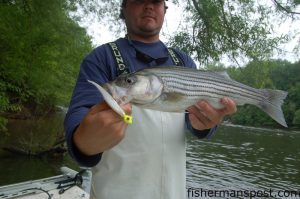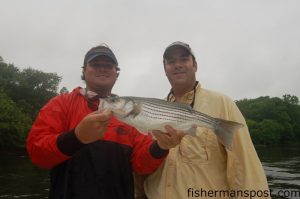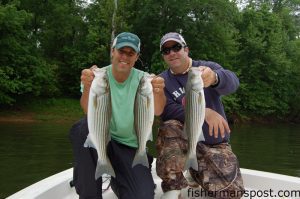Rockin’ Steady

Gary Hurley, of Fisherman's Post, with a rockfish caught near the boat ramp in Weldon. He was fishing with Capt. Richard Andrews, of Tar-Pam Guide Service, using live river herring on a Carolina rig.
“Some days you drop these live baits to the bottom,” said Capt. Richard Andrews of Tar-Pam Guide Service as he hooked what locals refer to as a “shad minnow,” even though they’re technically not shad but a mixture of juvenile alewife and blueback herring, onto a Carolina-style rig, “and they don’t even get to the bottom and you’ll get a bite. You’ll catch them every cast.”
Richard had brought me up to Weldon for a day of striper fishing on the Roanoke River, or rockfish as he calls them, and Adam Meyer, of Charter Lakes Marine Insurance, joined me on this trek up I-40 because his interest had been sparked by Richard’s boat show stories of one hundred fish days.
The three of us had only gone about 50 yards from the newly renovated boat ramp before we put the motor in idle and started into a drift. The threat of rain was in the air, but Richard, leisurely and with an air of confidence that there was no hurry to finding fish, gave us the basics on catching these rockfish on live bait.
You want to drop the bait all the way down, we were told, but not to keep the bait on the bottom or we’d get hung up. The technique was to feel your bait hit, and then give a couple of turns of the reel to bring up the bait so it was just off the bottom.
“Move your rod tip up and down to give it a little bit of action, and you’ll feel the bite,” Richard told Adam and me as we approached the first downriver bend. He showed us the desired movement by slowly lifting his rod up about two-three feet and then letting it drop while keeping the line tight.
I was optimistic and asked what to do when you get a bite.
“When you feel the bite, like right there…,” his thoughts were sharply interrupted as our first rockfish of the day was pulling a little drag after mere seconds of having a bait in the water.
“Just turn the handle and lift the rod tip up gently,” he continued, laughing a little at the irony of hooking a fish at the very moment he was talking about it. “These are circle hooks. We fish barbless circle hooks.”
Since we weren’t really fishing yet, more getting our day’s instructions from Richard and preparing to fish, I was unprepared and didn’t have the camera ready. I went to grab the Pelican box as Richard brought the fish to the boat.
“Look at them around him,” he told Adam who was moving his way to the back of Richard’s Pathfinder for a closer look. “You see them? He’s got three to four around him.”
Adam looked over the gunnel and gave confirmation, as I got in position for photos, that there were indeed several fish following our first fish of the day up the water column.
“That didn’t take long, did it?” Richard asked with an easy smile, knowing that any pressure he might have felt about producing fish while having a newspaperman on board had immediately been erased.
Now understanding (and seeing first hand) what to do when getting a rockfish bite, I asked what to do when the fish was at the boat.
Richard demonstrated as he answered me, “You can either grab them under the gill plate, or you can lip grab them, but they’re going to squirm on you. You need to grab him hard.”
With fish in hand, we snapped a couple of photos, and then Richard moved the boat away from the bank to get Adam and me ready to put some baits in the water. He showed us all the marks on his machine while we moved, identified them all as rockfish, and explained that fishing was slower on some days, and the fish may be finicky on others, but the river near Weldon was absolutely loaded with them.

When jigging for rockfish on the Roanoke, Richard prefers a Z-Man soft plastic on a chartreuse jig head.
We’re fishing in mostly 10-12 feet of water, using Carolina rigs with 3/4 oz. egg sinkers, 15-18 inches of fluorocarbon leader, and #1 or #2 circle hooks. Our live bait, the juvenile river herring, gave us an advantage over most of the other boats starting to congregate in spite of the slight rain that had now started to fall.
Richard invests a lot of time, energy, and ingenuity into getting these alewife and blueback herrings (when they’re juveniles it’s almost impossible to tell the difference) for his clients for their rockfish trips on the Roanoke.
The bait process starts the night before on the Roanoke Rapids Lake where he cast nets the fish right below the dam. Richard puts a light out in the water and will bring in good numbers when the bait cooperates.
He keeps the baits alive and healthy on his boat, he told me, thanks to a custom livewell, and before he can finish telling me about the strong filtration system that removes all of the scales they shed, Adam’s rod had bent over announcing his first Roanoke River rockfish.
This time the camera was handy, so I snapped a few photos and decided to ask fewer questions until I joined the rockfish party.
Richard went right back to talking about the moratorium on river herring, how it’s legal to take them out of the lake, he explained, just before Adam hooked his second rockfish of the morning.
This time I left the camera alone, told them they were welcome to take as many photos as they wanted, but I had to get focused on bringing up my own rockfish.
Richard, wanting to help my cause, suggested checking my bait. These aren’t hardy baits, and if it doesn’t look like it’s swimming, then I needed to get something fresh and alive on my hook.
I vowed to change my bait if the next drop didn’t produce, and then I felt a fish pick up my herring. Careful not to jerk, nor to feed it like a flounder, I followed Richard’s circle hook advice and lifted up the rod tip and turned the handle. The line came taut, and it was my now my turn to celebrate my first Roanoke River rockfish.
My single brought our fish count between the three of us to five fish, and glancing at the time I noticed that we had been drifting and fishing for all of fifteen minutes. The boat was averaging a fish every three minutes, and there was no reason to doubt that numbers would come everyone’s way.

Capt. Richard Andrews, of Tar-Pam Guide Service, with a lip grab on Adam Meyer's first Roanoke River rockfish.
Drifting is Richard’s preferred method. Usually his first drift of the morning is a long one, as it lets him cover a lot of water and look for big concentrations of striper marks on his machine.
“Lots of guys anchor up,” he explained, pointing to a screen full of rockfish marks, “but I like to drift because I get to scan the river on my machine as I drift to find out what’s going on.”
Adam, Richard, and I were now steadily catching stripers, including doubles and triples, when we heard a big eruption from the other side of the river. Tails, heads, and splashes broke the calm and quiet of the Roanoke, and Richard pointed to a big, milky cloud in the water. This is spawning activity, he told us. As the females come up to the water surface to release their eggs, they’ll be surrounded by 20-30 males who then release their milt. This spawning activity happens in an area about the size of the bow of a boat, and it happens throughout the morning hours.
And on call, reminiscent of the timing of his first fish of the day, another surface eruption happened just 10 feet off the front of the boat.
“Sometimes you can throw a topwater plug into them and twitch it,” he added, “and you’ll catch them on top.”
Richard’s knowledge of rockfish migration and spawning habits kept Adam and me intrigued, but with three guys on a boat a conversation about reproduction is bound to deteriorate at some point. Somewhere in the discussion one of us made a joke about male rockfish following up the “eruption” by getting a bite to eat and taking a nap. Then Richard shared a story about his buddy that was fishing a couple of days before when the spawning activity was so strong that he had male fish surrounding the blade of his trolling motor. Our captain ended the tale with, “That’s horny right there, buddy.”
A couple more drifts passed and the action was so consistent, all three of us pulling up rockfish on practically every drop, that we stopped counting fish. Richard had easily delivered on his rockfish guarantee, so he gave us a new challenge on this fourth drift. He put the live bait away and had us working artificials for our rockfish.
For plastics, he likes a Z-Man white paddletail with a chartreuse head. Adam and I readily accepted the new challenge, and though it took a few more minutes for each of us to land a fish, we both passed the artificial test in about 10 minutes. We continued working the same water as we had with bait, pulling up consistent fish though not quite as consistent, but Adam and I both seemed a little more proud of each rockfish caught while jigging.
In the spirit of covering all bases and giving Adam and I a sampling of all the different river techniques, Richard anchored up near a point bar—a big sand bar on the inside of a meandering bend—where the point usually holds a lot of fish. He had us cast our artificials out into the current and bring them back to the boat across the ledge, where the river depth quickly goes up to 10-12 feet from the 15-17 feet out in the body of the river. Anchoring for fish proves to be our hardest challenge, taking upwards of 20 minutes for each of us to bring in a striper.
Our time anchored up and under some cover from the increasing rain gives Richard an opportunity to tell us more about the history of this Weldon fishery.
Richard has served on the Advisory Committee for the Central/Southern Management Area for striped bass, and their region covers just south of Roanoke Island down to the NC/SC border. He also serves on the Advisory Committee for the Albemarle Sound Management Area, which oversees management decisions for the Albemarle/Chowan/Roanoke stock as well as the NC Wildlife Resources Commission’s Division of Inland Fisheries.

Gary Hurley, of Fisherman's Post, and Adam Meyer, of Charter Lakes Marine Insurance, took the drive up I-40 to Weldon for a half day full of catching stripers, including this triple display. They were fishing with Capt. Richard Andrews of Tar-Pam Guide Service.
“These rockfish are a true success story in fisheries management,” he proudly told us. “This is a multi-million dollar fisheries restoration project that has succeeded for a number of reasons. There’s been lots of stocking, and we negotiated with Dominion Power to get a steady dam flow from April 1 through June 15. They’re not allowed to operate peaking flows, and keeping the river steady has enabled the spawn to really take off.”
There are two groups of rockfish, he further explained, that are coming to the area to spawn. One group is traveling from the ocean, including some big 40-50 lb. females, but the main body of fish are resident fish in the Albemarle Sound. These are the same fish that anglers catch in the winter in Plymouth down at the mouth of the river.
Anchoring up was producing fish, but without it being red hot, Richard had no interest in staying anchored. He untied us from an overhanging tree limb, our river anchoring system, and guided us back into the lineup of the approximately 50 boats that were now working the same waters. The eclectic group included everything from canoes and jon boats, to big center consoles and bayboats like ours.
We continued long drifts, slowly covering new water farther downriver from the boat ramp, finding fish in just about every part of the river we covered, and at the end of one of our longest drifts we spotted a bald eagle perched at the top of a tree and quietly taking in its surroundings. Eagles are far from the only wildlife his clients enjoy on these trips, as he recalls sightings of ospreys, blue herons, deer, and even turkeys flying across the river.
The wildlife is only one of the reasons these rockfish trips out of Weldon are great for everyone, he noted. The live bait fishing is easy for inexperienced anglers or kids as young as 6-10 years old, and if experienced anglers are searching for more of a challenge, then Richard can get them tossing artificials, throwing topwaters (using modified Zara Spooks and other walk-the-dog style baits by taking off the trebles and putting on one single barbless j-hook), or working a fly rod for their quarry.
The bookings really start for Richard around the second week of April, and he’ll fish the river through the end of May. If you want to keep any rockfish, though, then fish from March 1 to April 30. During this time anglers are allowed two fish per person in the 18-22” slot, otherwise it is an all release fishery (other than an incidental catfish or white perch).
After May he goes back down to Washington to fish the Pamlico all summer for trout, flounder, and puppy drum, or he targets the big reds in August and September.
Shortly after lunch Adam and I both agreed we had our fill of rockfish, and we slowly passed the many boats still on drift and still catching fish on our way to the ramp. I’m not sure if Weldon produced a 100 fish day for us or not, but that’s mostly because I didn’t care to count anymore somewhere after 20-ish fish each.
If catching more stripers than you care to count sounds like an enjoyable half or full day on the water, then give Capt. Richard Andrews, of Tar-Pam Guide Service, a call and book your own Roanoke River rockfish trip. It’s enjoyable, full of action, and you’ll leave Richard’s boat knowing a lot more about rockfish, their spawning habits, ongoing fisheries management efforts, and the future of the fishery.
You can reach him at (252) 945-9715, or visit him online at www.tarpamguide.com.
